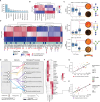This is a preprint.
Multi-omic landscape of human gliomas from diagnosis to treatment and recurrence
- PMID: 40161803
- PMCID: PMC11952471
- DOI: 10.1101/2025.03.12.642624
Multi-omic landscape of human gliomas from diagnosis to treatment and recurrence
Abstract
Gliomas are among the most lethal cancers, with limited treatment options. To uncover hallmarks of therapeutic escape and tumor microenvironment (TME) evolution, we applied spatial proteomics, transcriptomics, and glycomics to 670 lesions from 310 adult and pediatric patients. Single-cell analysis shows high B7H3+ tumor cell prevalence in glioblastoma (GBM) and pleomorphic xanthoastrocytoma (PXA), while most gliomas, including pediatric cases, express targetable tumor antigens in less than 50% of tumor cells, potentially explaining trial failures. Longitudinal samples of isocitrate dehydrogenase (IDH)-mutant gliomas reveal recurrence driven by tumor-immune spatial reorganization, shifting from T-cell and vasculature-associated myeloid cell-enriched niches to microglia and CD206+ macrophage-dominated tumors. Multi-omic integration identified N-glycosylation as the best classifier of grade, while the immune transcriptome best predicted GBM survival. Provided as a community resource, this study opens new avenues for glioma targeting, classification, outcome prediction, and a baseline of TME composition across all stages.
Conflict of interest statement
Declaration of interests M.A. and S.B. are named inventors on patent US20150287578A1, which covers the mass spectrometry approach utilized by MIBI-TOF to detect elemental reporters in tissue using secondary ion mass spectrometry. M.A. and S.B. are board members and shareholders in IonPath, which develops and manufactures the commercial MIBI-TOF platform.
Figures







References
Publication types
Grants and funding
LinkOut - more resources
Full Text Sources
Research Materials
